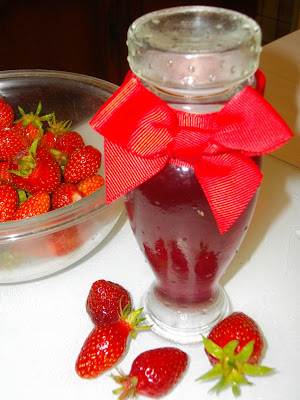Roses are beauty and fragrance workhorses. They grace views, fill vases extravagantly, add to the memorable quality of time spent in the garden because of their fabulous scent, and if that heavy duty was not enough, they offer an edible aspect with their hips and petals.
 |
| Rose bouquet doing its colourful, fragrant act on a cloudy day |
When checking how my twenty or so rose bushes are doing each day during their blooming season, I make various cutting decisions: for buds beginning to open, I cut those for bouquets, for flowers that have opened but still are mostly fresh--a few outer raggedy petals can be removed--I use for rosewater making, and for the ones that are close to dropping their petals, the compost awaits for them along with the faded bouquets. In late summer, I let some go to seed so I can harvest their fruits--vitamin C rich hips for jam and tea.
 |
| Observing my patio shenanigans, Dayo perches on a sous sol window sill |
ROSEWATER RECIPE
1) Choose the most fragrant roses of which the petals need to be separated from their stems and then washed. Red and deep pink petals will give nice colour to the rosewater. Use only roses not sprayed with chemicals. If you have no rose bushes of your own, you may find a neighbour or two that will let you have some of theirs. Gift them with some of your rosewater as a thank you.
 |
| Petals from my most fragrant roses |
 |
| Well washed petals resting in their strainer |
2) Put petals in a large non-aluminium metal, ceramic, or glass bowl, add boiling water to cover, and let steep overnight covered in the fridge.
3) Next morning, strain the rosewater into a large bowl. Then with well washed hands, grab a large fistful of petals from the strainer, squeezing them as dry as possible over the bowl holding the strained rosewater. Repeat until all petals have been hand-squeezed. Then re-squeeze to make sure to get the last precious drop.
 |
| Note the spent petals on the right |
4) Pour the rosewater into ice-cube trays, freeze, separate cubes, and place in a freezer bag. Take out desired amount when needed for cooking and the bath. When using rosewater in recipes, gradually add a few drops and always test taste as too much will make the dish tasting like perfume. The right amount however is sublime.
 |
| Tough day? Plop a couple of these in your bath. |
Culinary uses for rosewater abound. It can be added to the cooking water for rice and to cake/cookie batters. There are many wonderful recipes on the web. I wanted a simple, fairly low caloric recipe that uses my garden's present abundance of strawberries, so I devised the recipe below adding in another favourite fruit flavour of mine, raspberry.
 |
| Luscious Gariguettes fresh from the garden |
GLAZED FRESH STRAWBERRY PASTRY-FREE TARTELETTES
For each tartelette:
- Fresh, ripe, flavourful strawberries, about 15 medium strawberries
- Raspberry jam, several tablespoons
- Rosewater, a few drops
1) In a small pot, heat the raspberry jam till fairly liquid and add rosewater by drops to taste, then strain. If you use fruit jelly instead, there is no need for straining. Red currant jelly is often used for glazing strawberry tarts. If your strawberries are lacking flavour, a good strawberry jam could be used. Don't hesitate to experiment with various fruit jams/jellies
2) If buying, get the very best in terms of freshness and flavour. Sort strawberries--some for slicing and some to leave whole. If your strawberries are not small enough to be used whole for the top layer, slice off their tips. Layer slices in small ramekins or teacups up to about an inch from the top, keeping the layers fairly level. Pour some of the glaze on them, then place the tips or small whole strawberries on top with their bottoms sliced flat, and lay one large berry on its side in the middle, and re-glaze.
A dollop of whipped cream or vanilla ice cream would look nice, with maybe a dribble of the glaze. If a fancier look is wanted, then pipe the whipped cream around the centre strawberry, ending with a solitary rosette on that strawberry.
 |
| When watching calories, think flavour! |
I enjoy making lemonade with my home-made rosewater syrup. This syrup can be used in place of regular syrup in most cases. I top pancakes/French toast and sweeten coffee/herbal teas, plain yogurt, and cereal with it.
ROSEWATER SYRUP RECIPE
- 2 cups sugar
- 1/2 cup rosewater
- 1/2 cup water
Put water and rosewater into pot, bring to boil, add sugar, stirring until dissolved and syrup becomes clear, usually around five minutes--much longer and you will be making candy. Cool and pour into a covered container. It will keep at least a week in the fridge. I know that because we always eat ours within a week!
The light pinkish, violet-coloured water suddenly turned a stunning deep amethyst.
 |
| Rosewater syrup and Flastaff, one of the fragrant roses used |
On to making the lemonade. Squeeze some lemons, about one lemon for each glass.
Add cold water and rosewater syrup to taste--lemonade suddenly turns a bashful pink--and decorate with a lemon slice and a strawberry.
 |
| Pink lemonade! It actually is a colour closer to the nearby rose. |
As you can see rosewater is as adaptable as it is lovely, fragrant, and delicious. If you do buy it for cooking, make sure it is marked for culinary use.
Michelle's Astuce
If whole fresh lemons are placed in hot water for a few minutes, then squeezed, not only is much more juice produced, they are easier to squeeze.
RELATED POSTS



